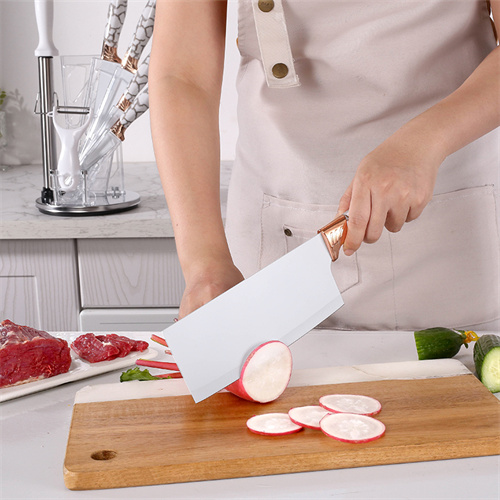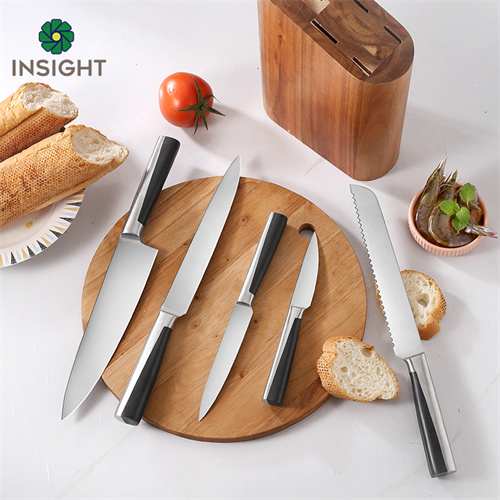

Views: 7000 Author: sales@insightknife.com.cn Publish Time: 2025-02-10 Origin: Site








Content Menu
● Understanding the Carving Knife
>> Design Features of a Carving Knife
>> Slicing Fruits and Vegetables
● Maintenance of a Carving Knife
● Differences Between Carving Knives and Other Kitchen Knives
>> Carving Knife vs. Chef Knife
>> Carving Knife vs. Slicing Knife
● Frequently Asked Questions regarding Carving Kitchen Knife
>> 1. What is the best material for a carving knife blade?
>> 2. How do I choose the right size carving knife?
>> 3. Can I use a carving knife for cutting bread?
>> 4. How often should I sharpen my carving knife?
>> 5. Is it safe to use a carving knife for beginners?
A carving knife is an essential tool in any kitchen, designed specifically for slicing cooked meats into thin, even portions. Its unique design and functionality make it a favorite among chefs and home cooks alike. In this article, we will explore the various aspects of carving knives, including their design, uses, maintenance, and the differences between carving knives and other kitchen knives. Understanding these elements will not only enhance your cooking experience but also help you appreciate the craftsmanship behind this vital kitchen tool.
Carving knives are characterized by their long, narrow blades, which typically range from 8 to 15 inches in length. The blade is usually thin and flexible, allowing for precise cuts. This flexibility is particularly important when carving meats, as it enables the knife to glide smoothly along the contours of the meat, ensuring that each slice is uniform. The pointed tip of the knife is designed to pierce through meat easily, making it ideal for carving roasts, turkeys, and hams. The handle is often ergonomically designed to provide a comfortable grip, which is crucial for maintaining control during slicing. Many carving knives feature a bolster, which is the thick junction between the blade and the handle, providing balance and safety while cutting.
There are several types of carving knives available, each suited for different tasks.
Traditional Carving Knife: This is the most common type, featuring a long, straight blade that is perfect for slicing large cuts of meat. Its design allows for smooth, even cuts, making it a staple during holiday meals or family gatherings.
Slicing Knife: Similar to a carving knife, but often with a slightly different blade shape, designed for producing thinner slices. Slicing knives may have a more pronounced curve, allowing for a rocking motion that can enhance the slicing process.
Electric Carving Knife: This modern tool uses a motor to power the blade, making it easier to slice through tough meats with minimal effort. Electric carving knives are particularly useful for those who may struggle with manual slicing, providing consistent results with less physical exertion.

The primary use of a carving knife is to carve cooked meats. Whether it's a holiday turkey, a succulent roast, or a glazed ham, a carving knife allows you to create uniform slices that are visually appealing and easy to serve. The long blade helps to maintain the integrity of the meat, ensuring that each slice is clean and precise. This is especially important when serving guests, as beautifully carved meat enhances the overall presentation of the meal. Additionally, using a carving knife can help retain the juices within the meat, resulting in a more flavorful dining experience.
In addition to meats, carving knives can also be used for slicing fruits and vegetables. Their sharp blades make it easy to cut through tough skins, such as those found on melons or squash. The precision of a carving knife allows for decorative presentations, such as fruit platters or vegetable garnishes. For instance, when preparing a fruit salad, a carving knife can help create uniform pieces that not only look appealing but also ensure even flavor distribution. The versatility of a carving knife makes it a valuable tool for both savory and sweet dishes.
While carving knives are specialized tools, they can also be used for various general kitchen tasks. From slicing bread to chopping herbs, a carving knife can be a versatile addition to your kitchen arsenal. However, it is essential to use the knife for its intended purpose to maintain its sharpness and effectiveness. Using a carving knife for tasks it wasn't designed for can lead to dulling the blade or damaging the knife, which can affect its performance in more critical tasks like carving meats.
Proper maintenance of a carving knife is crucial for its longevity and performance. After each use, the knife should be cleaned with warm, soapy water and dried immediately to prevent rust and corrosion. It is advisable to avoid placing the knife in a dishwasher, as the high heat and harsh detergents can damage the blade and handle. Instead, hand washing is recommended to preserve the knife's integrity. Additionally, storing the knife in a protective sheath or a designated knife block can help prevent accidental damage and keep the blade sharp.
A sharp blade is essential for effective carving. Regularly sharpening your carving knife will ensure that it performs optimally. You can use a whetstone, honing rod, or professional sharpening service to maintain the edge of the blade. It is recommended to sharpen the knife before significant uses, such as holiday meals or special occasions. A well-maintained edge not only makes slicing easier but also enhances safety, as a sharp knife is less likely to slip and cause injury. Learning the proper techniques for sharpening can be a valuable skill for any home cook.
Storing your carving knife properly is vital to prevent damage. A knife block, magnetic strip, or protective sheath can help keep the blade safe and secure. Avoid storing the knife in a drawer without protection, as this can lead to dulling and potential accidents. Proper storage not only prolongs the life of the knife but also ensures that it is readily accessible when needed. Consider designating a specific area in your kitchen for your carving knife, making it easy to find and use when preparing meals.
One of the most common comparisons is between carving knives and chef knives. While both are essential kitchen tools, they serve different purposes. A chef knife is a multipurpose tool designed for chopping, dicing, and mincing. In contrast, a carving knife is specifically designed for slicing cooked meats. The blade of a chef knife is typically shorter and wider, while a carving knife has a longer, narrower blade for precision slicing. Understanding these differences can help you choose the right knife for your specific cooking needs, ensuring that you have the best tools at your disposal.
Although the terms "carving knife" and "slicing knife" are often used interchangeably, there are subtle differences. A slicing knife is generally more flexible and may have a slightly curved blade, making it ideal for producing thin slices of meat. Carving knives, on the other hand, are more rigid and designed for larger cuts of meat. Knowing when to use each type of knife can enhance your cooking efficiency and improve the quality of your food presentation.
A carving knife is an indispensable tool for anyone who enjoys cooking and entertaining. Its unique design and functionality make it perfect for slicing cooked meats, fruits, and vegetables. By understanding the various uses, maintenance tips, and differences between carving knives and other kitchen knives, you can enhance your culinary skills and elevate your dining experience. Whether you are preparing a holiday feast or a simple family dinner, a carving knife will help you achieve perfectly sliced portions that are sure to impress your guests. Investing in a high-quality carving knife and taking the time to care for it properly will pay off in the long run, making your cooking endeavors more enjoyable and successful.

The best materials for carving knife blades are typically high-carbon stainless steel or high-carbon steel. High-carbon stainless steel offers a good balance of sharpness, durability, and resistance to rust, while high-carbon steel can achieve a sharper edge but may require more maintenance to prevent corrosion.
Choosing the right size carving knife depends on the types of meats you typically prepare. A longer blade (around 12 to 15 inches) is ideal for larger cuts like turkeys or roasts, while a shorter blade (around 8 to 10 inches) may be more suitable for smaller cuts or everyday use. Comfort and control are also important, so hold the knife to see how it feels in your hand.
While a carving knife can be used for cutting bread, it is not the ideal tool for this task. Bread knives, which have serrated edges, are specifically designed to slice through crusty bread without crushing it. Using a carving knife on bread may lead to uneven slices and can dull the blade.
The frequency of sharpening your carving knife depends on how often you use it. If you use it regularly, it is advisable to sharpen it every few uses. For occasional use, sharpening it before significant meals or gatherings is usually sufficient. Regular honing can also help maintain the edge between sharpenings.
Yes, beginners can safely use a carving knife, but it is essential to practice proper techniques and safety measures. Always use a stable cutting board, keep your fingers away from the blade, and ensure the knife is sharp. A dull knife can be more dangerous as it requires more force to cut, increasing the risk of slipping and injury.